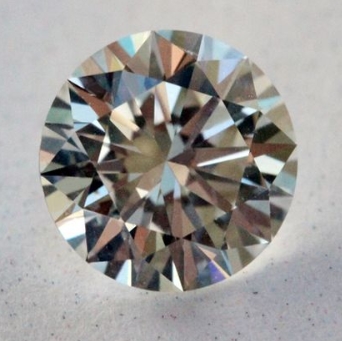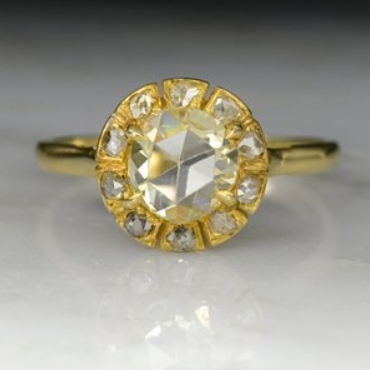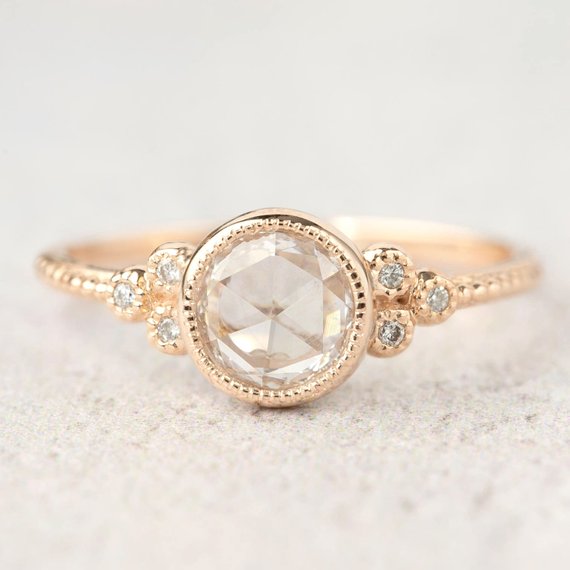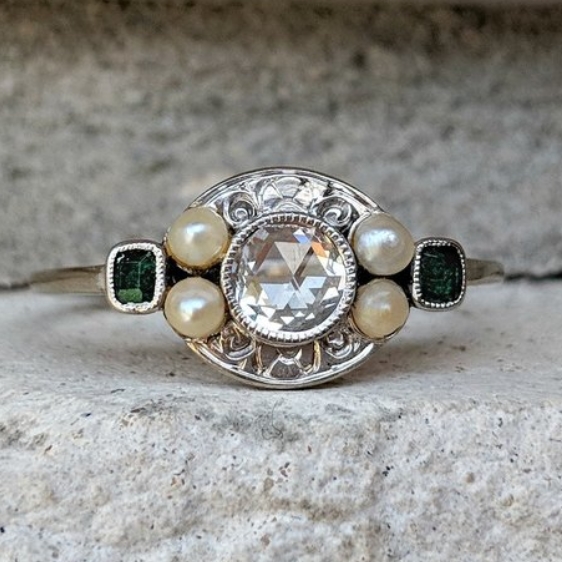Hey There! We may earn a commission from links on this page. This helps support the site and is at no extra cost to you. Thanks!
Rose-cut diamonds are known for their charm and personality. They have a soft, subtle look with a diffused light glow that is alluring and feminine.
The cut originated in the 16th century when jewelers, limited in tools and techniques, worked to bring out the natural beauty of the diamond. The stone is flat on the bottom with a dome-shaped crown with 3 to 24 triangular facets meeting in a single apex.
The cut is a magnificent representation of the unfolding petals of a rose bud.
History of The Rose Cut Diamond
Although the earliest diamonds were discovered in the fourth century BCE, diamond cutting did not begin until the 14th century. Actually, it was more shaping than cutting, such as polishing a diamond in its natural octahedron shape (picture a mirrored image of two pyramids) into a point for the point cut.
During the 15th century, the table cut and step cut were the first faceted diamonds.

Image from WikiCommons
By the 16th century, tools and techniques had improved and the rose cut was created.
Early on, the rose cut had three or six facets in a single row around the stone. Later, there were 12 facets in two rows. During the 19th century, 18-facet rose cuts were popular—so popular that savvy jewelers began using larger diamonds. The larger stones allowed for more facets, resulting in the full rose cut with 24 facets. Their popularity continued to soar, particularly once the cut was impeccably perfected in Belgium and the Netherlands. Also, with the arrival of an American rose cut, the diamond had a new continent with a new clientele to enchant.
Then, the fickle finger of fashion moved on, as it always must. The invention of steam-driven and electric cutting equipment plus the knowledge gleaned from centuries of expert diamond cutters made it possible to craft round diamonds. Thus, the modern round brilliant cut eclipsed the rose cut.

Rose Cut Diamond. Image via WikiCommons

Round Brilliant Diamond. Image via WikiCommons
Rose Cut vs. Modern Round Brilliant
The modern round brilliant cut was introduced in 1919. It’s not difficult to understand why it knocked the rose cut off its pedestal. New tools allowed for smaller facets cut with geometric precision, resulting in more facets that were more uniformly shaped.
Instead of 3 to 24 facets, the modern round brilliant had 57 facets with the culet being the 58th. The culet was a major innovation. Instead of the flat bottom of the rose cut, the modern round brilliant ended in a tiny flat-faced facet that let more light into the stone. The more light in, the more brilliance reflecting out.
At that time, the lovely glow of the rose cut could not compete. Never had anyone experienced the brilliance, fire and sparkle emanating from a gemstone. It was as though stars had been captured right out of the night sky.
Color and Clarity of Rose Cut Diamonds
Color
The rose cut diamond has a different relationship with color than other cuts. Color grades range from absolutely colorless (the rarest and most expensive) to lightly colored.
The beauty of the rose cut does not depend on where it falls on the color scale. In fact, a lower color grade may be preferable, because of soft tints of yellow or gray complement the shape of the rose cut where they detract from other cuts. Another advantage of the lower color grade is that it is budget friendly.
Clarity
The rose cut is not so accommodating when it comes to clarity as it is with color. Due to the transparency of the facets and high dome, inclusions (small imperfections created as the stone forms) are more noticeable than in other cuts.
You may want to choose a stone with a higher grade of clarity, but it will suffice if you find a stone that is “eye-clean” with no visible inclusions.
On the other hand, many collectors of vintage rose-cut diamonds value the inclusions that give a stone charm and a distinctive personality.
Why Buy a Rose Cut Diamond
The rose-cut diamond tends to appeal to those who forge their own paths through life, those not inclined toward the “flavor of the month” in anything. The rose cut has a sophisticated luster. It’s cool and edgy rather than flashy. It’s Old World, romantic and ultimately feminine.
On the practical side, your money goes farther with a rose cut.
The rose cut makes a diamond visually larger than its actual carat weight—in fact, much larger than another cut of the same carat weight, because all of the carat weight is displayed on the surface area of the dome.
We’ve already seen that you need not buy a stone on the higher end of the color scale. As you go down the scale, the price goes down accordingly. It’s a smart way to have a stunning diamond without being weighed down with debt.

Vintage Rose Cut Diamond Ring from Pebble and Polish on Etsy

Modern Rose Cut Diamond Ring from Envero Jewelry on Etsy

Antique Art Deco Rose Cut Diamond Ring from Cypress Creek Vintage on Etsy
Tips on Buying Vintage Rose Cut Diamond Jewelry
Of course, the first step is to find a reputable vendor. You are here, so you’ve completed that step very nicely.
- Decide on a budget and don’t be lured away from it.
- Decide if you want a piece of jewelry that you can wear every day or for special occasions only. That will narrow down your choices. Read about different gem settings and choose one that fits your lifestyle.
Other than those, there are not many rules to follow. Try to avoid the “shoulds,” such as:
You should buy as colorless a diamond as you can afford. Colorless stones in a rose cut can look icy, while tinges of colors, such as gray, champagne, light brown and yellow, give definition to the petal design. What is more important than the actual color or tint is that the stone be full of life. It’s hard to describe—you’ll know it when you see it. It’s a stone that does not remind you of a cloudy day. Instead, you see sunlight skipping through it.
You should look for a flawless diamond. For one thing, vintage beauty rarely includes perfection, so you might be looking for your rose cut a very long time. More important, it is the imperfections that give each stone its unique personality. On the other hand, there are imperfections that can ruin a stone, so examine it carefully. An inclusion that is too close to or on the surface creates an unattractive rough patch. If there is a small crack in the surface, you can be sure there is an extensive flaw in the structure of the diamond. With flaws of this nature, something as seemingly minor as a change in temperature will crack it more.
The best way to find the rose-cut diamond of your dreams is to simply trust your instincts—go with a stone that attracts you, that “speaks” to you, not one that fits someone else’s criteria.
If you want to have some fun while gaining more knowledge, visit The Best Vintage Jewelry Shops on Etsy for some beautiful examples of the vintage rings available. If you are looking for a modern rose-cut diamond ring, visit The Best Engagement Ring Shops on Etsy.What do you think of rose cut diamonds? Personally, they are my favorite type of diamond cut. If you liked this article, please share it with your friends. And, let me know if you have any questions in the comments below! I love to help 🙂
Go Get Your Glow On,
Andrea

